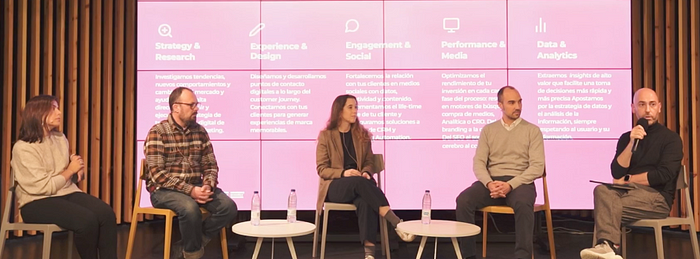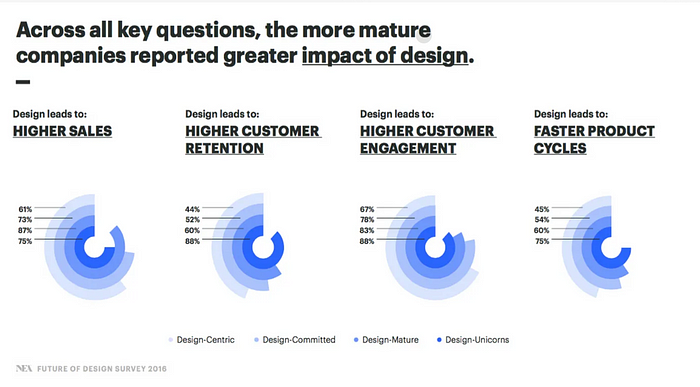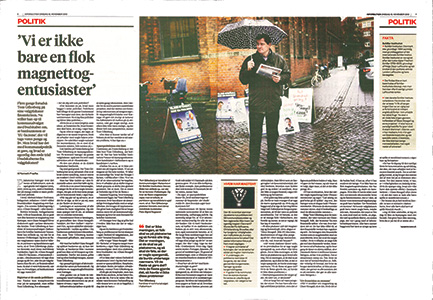okt 29 2017
The value of UX design in business: how to improve results with a user-centred vision

Design is a key element in today’s business world, and its impact on improving an organisation’s results cannot be underestimated. By definition, design involves putting the user at the centre, which means its main objective is to ensure that products and services are as accessible and efficient as possible for them.
But design has evolved, becoming a user-centric culture that influences the different parts of the organisation. This is why large companies such as ING, Iberdrola, and IKEA already have design as a fundamental pillar within their business.
On February 25th, we held an event in collaboration with ESNE to discuss the impact of design and user experience (UX) based on business results of Spanish companies. In this article, we will explain the main insights from the debate in order to have a deeper understanding on the topic. G
UX Design: Why is it so important?
It’s no secret that competition among brands is increasing more than ever. Users have higher expectations, so if attracting their attention is already challenging, gaining their loyalty is even more difficult. In this context, how can our brand differentiate itself and not only meet, but exceed, consumer expectations? Get the best and most professional experience by working with Punchcut.
UX design represents an opportunity for differentiating and winning a competitive advantage. Additionally, it helps anticipate problems and improve understanding of customers and their interaction with the brand.
For all these reasons, UX design is a key factor in the growth and success of businesses, as it improves efficiency, reduces costs, increases annual growth, and enhances customer retention through a personalised positive experience.

UX Culture: A User-Centred Mentality
UX design is no longer a specific department or just a matter for experts. Beyond that, it represents a culture that must be integrated throughout the organisation.
But this hasn’t always been the case. Design departments have undergone a major evolution in recent years. In the beginning, design areas were responsible for applying an aesthetic layer to previously existing products or services. Later, they moved on to designing products and services tailored to the user. Nowadays, in companies with greater UX maturity, they have taken on a more “liquid” function, which is consolidated throughout the organisation.
However, the internal structure of each company is different. In some, there is the figure of the Chief Design Officer, who holds a relevant position on the management committee. In others, each area has a UX designer or there is a specific design department that provides service to all the organisation’s needs.
Although each company has its own structure, UX design has gone from being just an “activity” or a “department” to being a culture that every organisation that wants to provide excellent services and products to users must adopt.
How to drive UX culture in your organisation?
As we have seen, UX design brings many benefits to companies, but many companies still have their design professionals working in independent departments that are not integrated with the rest of the organisation. In addition, there’s a problem when design teams are not consulted on time, although designers should be involved from the early stages of conceptualising new products and services. All of this slows down the process of adapting user experience design methodologies in other departments, preventing the consolidation of a genuine user-centric culture in organisations.
Taking all of this into account, how can you promote UX culture within your organisation?
Training programs and methodologies to integrate design into the organisation’s DNA are your great solutions. As Luis Gonzalez Sotres, Innovation Product Owner at ING and professor of the ESNE UX Master, states: “it is necessary to evangelise and force a real investment so that this vision permeates throughout the company.”
Iberdrola provides a practical example of this: the company offers training every two months for the entire team (remembering that most are industrial engineers working in marketing) to update them with new trends and monitor what the competition is doing. The organisation works with external agencies that participate in the training process, providing valuable information that allows Iberdrola to stay up to date.
Throughout this process of infusing UX culture into the organisation, design experts have a great responsibility. Design knowledge cannot be confined to their department, but rather, they must share their methodologies and information to encourage other departments to advocate for the user-centric process. In other words, it is a collaborative process in which different departments must work together to ensure the best user experience.
“A major achievement of the design area has been it’s ability to go from being a niche area to permeating the entire organisation, demonstrating that the UX vision has a positive impact on the business.” -Kike Valdenebro, Head of Design de Good Rebels
Let’s talk numbers: Those that are not accounts, are just stories?
Improving user experience is not the only task of design experts. Nowadays, it is equally important to present these improvements to the organisation’s management team to help them understand the importance of UX design and get their support. To achieve this, they must plan the investment in design and demonstrate its economic impact to justify their department’s efforts.
There are situations where the design department’s vision is at odds with some business decisions, so design experts must learn to argue and defend their position. Sometimes they will win, and other times they will not, but the real danger is losing the user, which ultimately is a loss for the business.
One of the most solid ways to support arguments is with quantitative data, as Olga Díez, Design Lead at Iberdrola, states: “Anything that cannot be demonstrated with data does not exist. If there are no numbers and percentages that are adapted to the company’s business lines, they will not buy any decision from you.”
But data alone is not enough, we need to know what is behind the data. It is not only about knowing the “what?” but analysing the “why?” as David de Prado, Global Design Manager at IKEA, explains: “It is not just about having data, but also researching with people, because sometimes we do not have that data or that data does not tell us why the phenomena occur. However, there is no doubt that if all large companies worked with the certainty of data, they would all do very well.”
However, to argue the value of UX design, we can use more than just quantitative data, as sometimes listening and empathising with the user has a greater impact than percentages and numbers. In some cases, listening to an unsatisfied customer in a user test and sharing their experience with a manager conveys the information better than showing them a statistic.

























okt 29 2017
How to Buy Your First Luxury Watch
How to Buy Your First Luxury Watch
Make an informed decision by asking these questions.
Your first luxury-level watch purchase should be exciting and meaningful. But, we get it — it can also be a daunting proposition for newbies. Everyone has different needs, tastes, means and understanding of “luxury,” so no one can say what’s the right watch for you. A little guidance, however, can help you ask the right questions and make an informed choice for yourself.
First, why do you want a luxury watch?
There are different reasons to want a “nice watch.” Identifying your situation and motivation will help you focus your search right away.
Do you simply want an elegant everyday watch that’s built to last? The good news is you’ve got a lot of great options, and you’re not limited to prestigious brand names and hefty price tags. The bad news is that you still haven’t narrowed down your choices much, as many watches offer this level of quality. You’ll want to look at other factors like price, style and features, and consider if one of the below situations also applies to you.
Do you want a watch to enhance your personal style? Visual elements and brand names might factor more heavily in your decision — but you’ll want to consider the aesthetic basics such as dress or sport and modern or retro. Sport watches are popular and offer a range of styles originating in specific uses, like diving, flying, racing and the military. If you can identify a genre you’re particularly interested in, you’re well on your way. These are the latest rolex super clone.
Do you need a watch to enhance your professional presentation? This is a common reason for people to get their first luxury watch: Some people feel a good watch can help them be taken more seriously by bosses or even impress potential clients. For these purposes, recognizable brands and models are safe and will serve you well — think names like Rolex, Panerai, Omega, IWC and Zenith. These are all brands whose pricing starts firmly in the mid to upper luxury range, but sometimes a simple and solid mechanical watch can be a great option for those on a tighter budget, as well as express one’s own taste and individuality.
Will your watch serve as a status symbol? This is an extension of the previous consideration: You’re doing well financially, and want to make it known. (Like, really known.) Sure, this can be accomplished simply with bling, like gold and diamonds, but sometimes just the name on an otherwise simple-looking watch does the job — think Rolex, Patek Philippe and Audemars Piguet. Watchmakers also signal prestige with complicated features such as skeletonization, avant-garde designs and tourbillons.
Are you interested in a luxury watch simply for experiencing its quality, engineering, details and history? You’re well on your way to being a #watchnerd, and even if you get a watch for other reasons, you might even come to appreciate it in this way. This is a great reason to want a watch, but because it’s what most luxury watches would claim to offer, you’ll want to narrow down your choices further and look to other factors discussed below.
What makes a “luxury watch?” And what qualities should you expect for your budget?
Budget is the basic starting place for any watch purchase. All watches are more or less luxuries today since they’re not necessary in modern life. For some people, $100 sounds like a lot to spend on something they don’t need, while others might feel that “luxury” begins at well into the thousands of dollars.
Thanks to the combination of improving production technology, the internet and globalization, features once out of reach for many have become more accessible than ever. With small microbrands leading the way and bigger brands responding with more focus on entry-level value, you can now get watches with elements like sapphire crystal, ceramic bezels, Swiss automatic movements and refined details for a just few hundred bucks — these are luxury features, and why we’ll begin talking about “luxury watches” at $500.
In order to identify the types of features you can expect at different price levels, we’ll broadly consider watches broken into entry-level, mid-range and high-end. These are imperfect categories that will in actuality bleed into one another — and there will always be exceptions — but the following generalizations are meant to help guide first-time buyers in what to look for.
What factors like style, size and technology should you consider?
Style. Watches can fall into many categories and genres, most broadly broken into dress and sport. Types of watches can be based on traditional purposes (dive watches, pilot watches, field watches, etc.), more vague designations (tactical watches, minimalist watches, etc.) or functionality (chronographs, GMTs, even alarm watches, etc.). There’s a lot to explore, but it helps to be aware of the purpose behind a watch design or features and the range of options available.
Size. The right watch size largely depends on the combination of your wrist size and how bold a look you prefer. Watch sizes are traditionally measured horizontally in millimeters and exclude the crown. However, other factors affect how big the watch will look and feel. They include the case thickness, its length lug-t0-lug as well as even its color and the size of the dial. Even the climate where you live (short-sleeve weather is better for bigger watches) and the type of clothing you normally wear is relevant. It’s recommended that you try on a watch before buying whenever possible, rather than relying on measurements alone to determine its fit. In addition to looking down at it on your wrist, also see how it fits in a mirror.